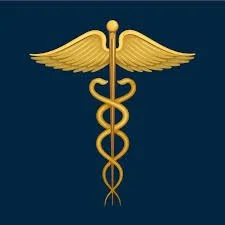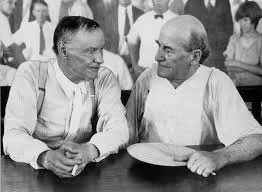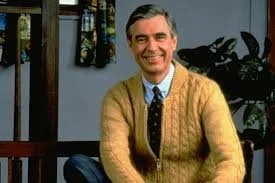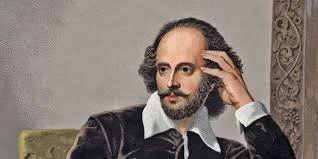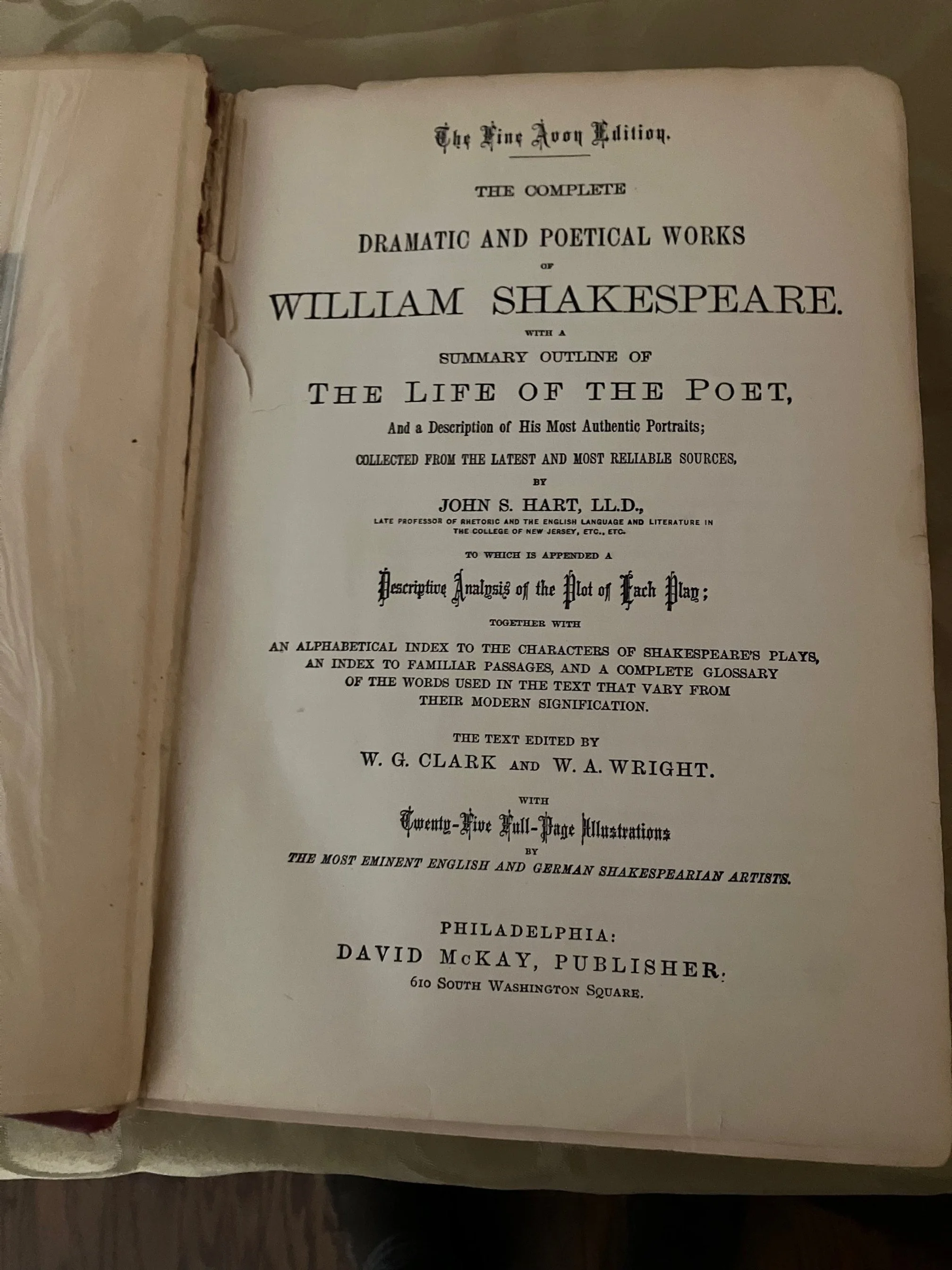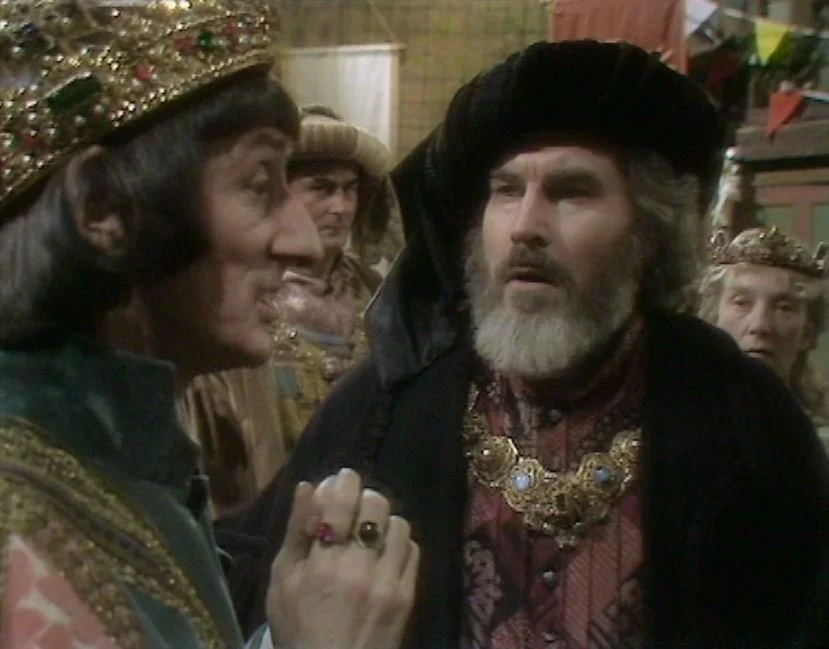#1,058: "Sane Washing"
Attorney Joseph Welch (1890-1960)
On June 9, 1954, during the historic “Army-McCarthy Hearings” held in Washington, D.C. (and viewed live on nationwide television), the Wisconsin senator Joseph McCarthy (R-WI) charged then-Secretary of State Dean Acheson with having sold America out to the Communists. He further charged that the Truman administration was riddled with subversion; and that the men and women who guided the country for the previous 20 years, were Communist dupes.
Harvard-trained attorney Joseph Welch (a Bostonian who represented the Army in the hearings), thrust a verbal saber through the Wisconsin senator’s political heart, first stating Until this moment, Senator, I think I never really gauged your cruelty or recklessness.
Then, In a mere 21 words, the balding Welch (1890-1960), sent McCarthy (derisively known as Tail-gunner Joe) on a downward spiral that would see him become a public pariah, and then, within less than 3 years drink himself to death at age 47.
The 21 words?
Have you no sense of decency, sir, at long last? Have you left no sense of decency, sir, at long last?
Ever since January 20, 2025, the date Felon#47 took his second non-consecutive oath-of-office, I have found myself wishing, hoping and praying that somehow the late Mr. Welch could reappear as some contemporary public servant’s doppelgänger; some man, woman or even educated child who would call out IT (and the various nefarious members of his revolutionary regime); someone who would and could stand up and clearly state that he/they are nothing more than a bunch of treacherous, addlepated lawbreakers who are an absolute disgrace, and should thus be tossed out on their collective rears for the good of both America and the rest of the world.
Of course, a single heroic person - like Joe Welch - cannot be expected to turn back the tide in 2025; oh so much has changed in the past 70+ years. Back in 1954, most people got their news from - in order:
Local and national newspapers;
Local and national radio broadcasts;
Local and national television.
Over the past two generations, we have become inundated with so many sources of online “news,” ranging from websites and blogs, to podcasts, cable broadcasts and what one might collectively term “cyber dreck.” Indeed, for every taste, inclination or fear, there are tens of dozens of matching “authorities” or references. Back in 1954, Joseph Welch’s 21-word putdown of “Tail Gunner Joe” acted as a national political muscle relaxant; first, because he was the right man at the right time and the right place; and second, because there were so very, very few sources of communication . . . especially for one who spoke the plain, unvarnished, non-hyperbolic truth.
Today, of course, it would take an army of Joe Welches to have as much of an impact as a single person speaking the unvarnished truth. And today, the need for that truth is as essential as at any time in our nation’s history. Consider that in the 10 months and 4 days since our Blessed Little Pouter Pidgeon took his 2nd oath of office, he has made the following statements (and performed the following acts) in public:
Claimed in a speech at the Iowa State Fairgrounds that before his return to office, the U.S. was “close to death.”
In the same speech alleging that he had “completely obliterated” Iran’s nuclear weapons capabilities, boasted that the only jobs lost under his administration were those held by illegal immigrants, and that he’s fighting “an illegal alien invasion”
Has repeatedly asserted that he is a better president than George Washington and Abraham Lincoln.
Welcomed Saudi strongman Prince Mohammed bin Salman at a lavish state dinner, literally rolling out the red carpet, greeting him with a ceremony that featured marching bands, flag-carrying horsemen and a military flyover. When questioned about the prince’s involvement in the killing and dismemberment of Washington Post columnist Adnan Khashoggi, POTUS actually stated: "You're mentioning somebody that was extremely controversial . . .”, referring to Khashoggi. "A lot of people didn't like that gentleman that you're talking about. Whether you like him or didn't like him, things happen, but he (bin Salman) knew nothing about it. And would you leave it at that? You don't have to embarrass our guest by asking a question."
Publicly stated that the half dozen members of Congress (Sen. Elissa Slotkin, Sen. Mark Kelly, Rep. Jason Crow, Rep. Maggie Goodlander, Rep. Chris Deluzio and Rep. Chris Houlahan - all of whom previously served in the military or intelligence community) who made a 1-minute video urging the military and intelligence community to “refuse illegal orders” should be hanged for sedition and treason. (“SEDITIOUS BEHAVIOR, punishable by DEATH” IT wrote in one of his messages on Truth Social) In statements by House Speaker Mike Johnson and White House Press Secretary Karoline Leavitt they danced around their boss’s call for hanging members of Congress. The Speaker said Felon47’s statement was not a call for Democrats to be executed, but instead were only the POTUS merely expounding on a legal question. Huh?
Told a reporter for Bloomberg News whose question he did not like “QUIET PIGGY!” When asked about this, Press Secretary Levitt claimed that her boss was merely showing that he’s “frank and open.” Not a word was heard from anywhere else within the MAGA ranks . . . except for retiring Marjorie Taylor Greene, who found the response contemptible. (It should be noted that the Georgia Republican becomes vested in her congressional pension in the first week of January, 2026).
Now mind you, the above bullet-pointed issues, words and events are but a mere handful of the egregious, irrational things POTUS, members of his regime, and MAGA republican members of Congress have been engaging in. In terms of response, Democrats have been pretty damn loud; major media outlets fairly muted (perhaps out of fear); IT’s Republican colleagues on Capitol Hill as mute as Marcel Marceau (but not one millionth as entertaining). No, what Republicans from the Cabinet to the White House Press Office to the vast majority of members of the House and Senate have been practicing is what one might call Sane Washing, herein defined as “The act of media or public figures framing someone's radical or extreme ideas. statements, and actions in a way that makes them seem normal and acceptable.”
Perhaps, just perhaps, a small tide is beginning to turn; Felon#47’s inanity, boorishness and pro-Fascistic personality are beginning to wear a bit thin. Perhaps some MAGA Republicans are awakening to the fact that:
Tariffs are not good (let alone great) for anyone but billionaires;
That gifting Argentina’s fascist government with $20 (or is it $40?) billion to prop up their beef industry while American ranchers are staring down the barrel of economic ruin is insane;
That transforming the entire Department of Justice into one’s own personal law firm makes a mockery of American justice;
That publicly insulting and threatening any- and everyone - who disagrees with you, is both boorish and unbefitting for the most powerful person on the planet;
That continuing to tell lies both in print and in front of the world’s cameras is causing this nation to take a nose-dive in the estimation of our allies.
That trying to convince “just plain folks” that you are on their side, while obviously caring only for billionaires, is the height of hypocrisy;
That permitting ICE agents (many of whom have no training or skills suitable to their assigned tasks) to kidnap, beat and then deport human beings - many of whom are American citizens - is going to lose you tons upon tons of votes.
That blowing up Venezuelan boats and trawlers in the name of "ridding America of Fentanyl” is against International and American Constitutional law. (It should be noted that just minutes ago, it was announced that IT and Defense Sec. Peter Hegseth ruined the holiday season for our troops by canceling and restricting their leave for both Thanksgiving and Christmas as they prepare to wage war against Venezuela and their president, Nicholas Maduro, whom they have now officially labeled an “international narco-terrorist.”);
That sending National Guard troops to roam the streets of Washington, D.C., Los Angeles, Chicago, Seattle, and New Orleans in the name of “fighting crime” is unconstitutional;
And on and on and on.
To be certain, there are plenty of Democrats who are in no way backing down when it comes to calling out POTUS and members of his regime for the lying, thieving anti-democratic people they really are. Think of Democrats like Senators Adam Schiff (CA), Amy Klobuchar (WI) Elissa Slotkin (MI) Mark Kelly (AZ) and Charles Schumer (NY) as well as Reps. such as Ocasio-Cortez and Dan Goldman (both of NY), Rosa De Lauro (CT) Al Greene and Jasmine Crockett (both TX) and Eric Swalwell (CA). (Mind you, this is but a tiny list at this point). And, as of today, it looks like California Governor Gavin Newsom will be running for the Democratic nomination for POTUS in 2028.
Dear reader: do not be deluded into thinking that replacing the current POTUS (and House and Senate) with Democrats will immediately solve all our social, cultural, economic and political problems. The fact of the matter is that IT DOESN’T TAKE NEARLY AS LONG TO TURN PEOPLE AGAINST ONE ANOTHER AS IT DOES TO BRING THEM BACK TOGETHER; IT IS FAR MORE DIFFICULT TO FIND THE GOOD IN PEOPLE WHO HOLD DIFFERENT OPINIONS OR RELIGIOUS BELIEFS THAN IT IS TO DRIVE A WEDGE BETWEEN THEM.
America is in for a couple of decades of social/cultural/political repair. But, as the ancient Chinese adage teaches: A journey of a thousand miles begins with a single step. That step can involve letting your senators and representatives know that you will only support and vote for those who have the courage to put distance between themselves and the regime; who have both the grit and compassion to admit that there is good in all people . . . regardless of their gender identity, ethnicity, color or economic status.
Learn our history; get to know the principles upon which our nation was founded . . . and above all, know that nothing can wash away or purify the insanity of a dictator except direct action.
Wishing one and all a happy, healthy, delicious, and caloric Thanksgiving,
KFS.
Copyright©2025 Kurt Franklin Stone

























